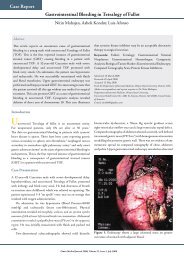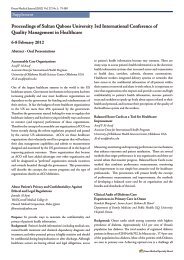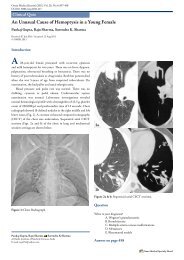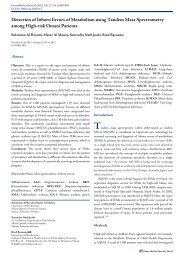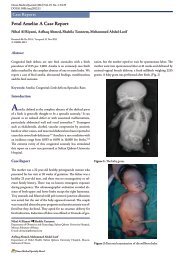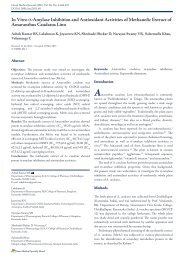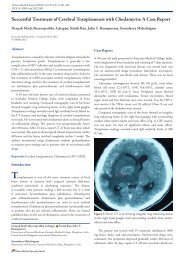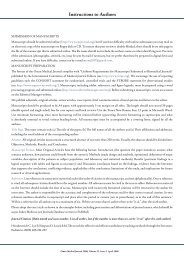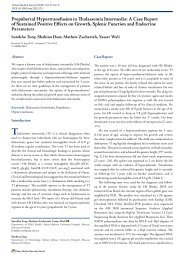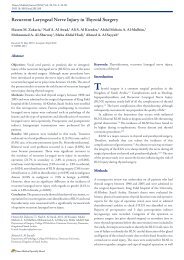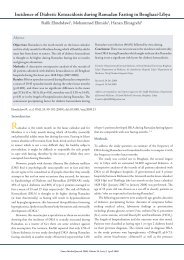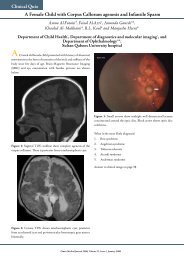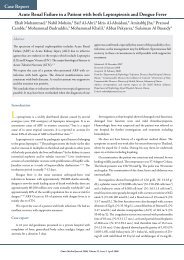External Ophthalmomyiasis due to Oestrus Ovis: A Case ... - OMJ
External Ophthalmomyiasis due to Oestrus Ovis: A Case ... - OMJ
External Ophthalmomyiasis due to Oestrus Ovis: A Case ... - OMJ
Create successful ePaper yourself
Turn your PDF publications into a flip-book with our unique Google optimized e-Paper software.
<strong>External</strong> <strong>Ophthalmomyiasis</strong> <strong>due</strong> <strong>to</strong> <strong>Oestrus</strong><br />
<strong>Ovis</strong>: A <strong>Case</strong> Report from Oman<br />
Abdelhameed A. Abuelhassan<br />
Abstract<br />
Human myiasis has been reported from various regions in the<br />
world. We report a human case of external ophthalmomyiasis<br />
caused by the larvae of a sheep nasal botfly, oestrus ovis, from<br />
Wadi Alhawasna, North Batina, Oman. A 9-years-old boy<br />
presented with symp<strong>to</strong>ms of acute conjunctivitis. Five larvae<br />
were removed from his eye and sent for identification. The patient<br />
recovered completely after removal of the larvae.<br />
From the Department of General Practitioners, Wadi Al Hawasna Hospial.<br />
Received: 30 June 2010<br />
Accepted: 14 Aug 2010<br />
Address correspondence and reprint request <strong>to</strong>: Abdelhameed A. Abuelhassan,<br />
Medical Officer In-Charge, Wadi Al Hawasna Hospital, P.O. Box 440, Khaboura<br />
326, North Batina, Sultanate of Oman.<br />
Email: abdelhamid1427@yahoo.com<br />
doi:10.5001/omj.2010.94<br />
Introduction<br />
Miasis is the infestation of tissues or organs of animals or man<br />
by fly larvae. Human ophthalmomyiasis is mainly seen in people<br />
who are in contact with animals, in particular sheep and goats.<br />
The sheep nasal botfly, oestrus ovis, is by far the commonest cause<br />
of human ophthalmomyiasis. The normal hosts for the larvae are<br />
sheep and goats. Occasionally, humans are the intermediate hosts.<br />
<strong>Case</strong> Report<br />
A 9-years-old boy presented <strong>to</strong> the Outpatient Department in<br />
February 2009 with a 1-day his<strong>to</strong>ry of foreign body sensation<br />
and excessive watering from his right eye. He developed these<br />
symp<strong>to</strong>ms after being struck in his right eye by a fly. He was<br />
absolutely fine before that and had no significant ocular or medical<br />
his<strong>to</strong>ry. On examination; his visual acuity was 6/6 in both eyes.<br />
Examination of his left eye was normal. Eyelids of the affected<br />
right eye were normal. The conjunctiva was mildly congested with<br />
profuse lacrimation in the right eye. Five Larvae were removed with<br />
cot<strong>to</strong>n buds from the conjunctiva, preserved in 70% alcohol and<br />
sent <strong>to</strong> the Veterinary Research Centre, Ministry of Agriculture<br />
and fisheries, Muscat for identification. Topical antihistaminic<br />
and antibiotic drops were given <strong>to</strong> the patient. The patient came<br />
for a follow-up after two days and he was completely relieved of his<br />
symp<strong>to</strong>ms. Examination of both his eyes was normal. The larvae<br />
were identified as the first instar of <strong>Oestrus</strong> <strong>Ovis</strong>. (Fig. 1)<br />
Discussion<br />
<strong>Ophthalmomyiasis</strong> is classified as ophthalmomyiasis externa if the<br />
larvae are present in the conjunctiva and ophthalmomyiasis interna<br />
when there is intraocular penetration of larvae. 1 The symp<strong>to</strong>ms of<br />
ophthalmomyiasis externa are of acute conjunctivitis with soreness,<br />
Figure 1: First instar of <strong>Oestrus</strong> ovis<br />
lacrimation and conjunctival congestion. The symp<strong>to</strong>ms of rhinitis<br />
in association with conjunctival reaction have been reported. 2<br />
<strong>External</strong> ophthalmomyiasis can be complicated by corneal ulcer,<br />
decreased vision or invasion in<strong>to</strong> eye globe. Apart from mechanical<br />
removal, there is no other therapy described. Topical antibiotics<br />
are useful in preventing secondary infection by bacteria. <strong>Case</strong>s of<br />
ophthalmomyiasis externa have been reported from various parts<br />
of the world. 1,3 To the best of our knowledge, this represents the<br />
third case reported from Oman of ophthalmomyiasis caused by<br />
<strong>Oestrus</strong> <strong>Ovis</strong>. 4,5<br />
Conclusion<br />
Doc<strong>to</strong>rs in Oman should suspect ophthalmomyiasis in unilateral<br />
conjunctivitis with a foreign body sensation.<br />
Acknowledgements<br />
The author reported no conflict of interest and no funding was<br />
received on this work.<br />
Oman Medical Journal 2010, Volume 25, Issue 4, Oc<strong>to</strong>ber 2010
<strong>External</strong> <strong>Ophthalmomyiasis</strong>... Abuelhasan<br />
References<br />
1. Gupta VP, Baveja UK. <strong>Ophthalmomyiasis</strong> externa caused by the sheep nasal<br />
botfly <strong>Oestrus</strong> ovis. Indian J Ophthalmol January-March 1988;36(1):41-42.<br />
2. Mazzeo V, Ercolani D, Trombetti D, Todeschini R, Gaiba G. <strong>External</strong><br />
ophthalmomyiasis. Report of four cases. Int Ophthalmol December<br />
1987;11(2):73-76.<br />
3. McDermott S, Schafer MD. <strong>Ophthalmomyiasis</strong> <strong>due</strong> <strong>to</strong> <strong>Oestrus</strong> ovis in South<br />
Australia. Med J Aust February 1983;1(3):129-130.<br />
4. Vic<strong>to</strong>r R, Bhargva K. <strong>Ophthalmomyiasis</strong> in Oman: a case report and comments.<br />
Wilderness Environ Med 1998;9(1):32-35.<br />
5. Shenoy R, Yanamadala S, Idris MA. Follicular conjunctivitis secondary <strong>to</strong><br />
external ophthalmomyiasis <strong>due</strong> <strong>to</strong> larvae of oestrus ovis, Delhi journal of<br />
ophthalmology 2001; 9(1):73-75.<br />
Oman Medical Journal 2010, Volume 25, Issue 4, Oc<strong>to</strong>ber 2010



